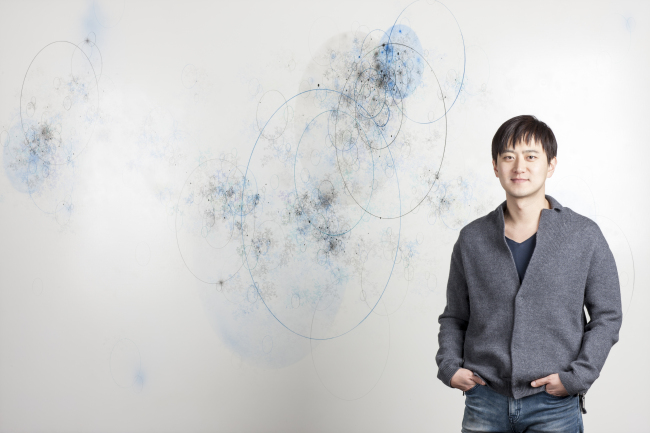New generation of Korean abstract art
Artist returns to local art scene after seven-year break with paintings exploring ‘true meaning of painting’
By 박형기Published : Jan. 17, 2016 - 12:52
Amid the unprecedented boom of Korean art in the global art scene driven by the popularity of dansaekhwa, monochrome painting, Korean galleries are raising their antennas to search out the post-dansaekhwa generation.

In their relentless search for new artists, Arario Gallery has introduced artist Lee Kang-wook in its first exhibition of the fresh new year.
Lee has just returned to the local art scene after a seven-year hiatus. In 2009, Lee left Korea to study in the U.K. at the peak of his early art career.
He rose to fame soon after he graduated from the prestigious Hongik University art school in Seoul in 2002. His paintings, exploring both microscopic and macroscopic worlds represented as images of cells and star explosions, were popular in the art market at the time.
In his solo exhibition, Lee presents 16 new paintings resulting from his seven years of in-depth exploration of “what a painting is.”

“I thought about why I paint and what does a painting mean to me while I was in the U.K.,” he said at the press preview last week. He received a master’s degree from Chelsea College of Art and Design and earned a doctorate from the University of East London.
He turned to explore the elements that constitute a painting, such as composition, color and brushwork, in order to find his own identity in painting.
“The gesture brushing identifies who the artist is. You can see paintings of Vincent Van Gogh and Jackson Pollock without their names and still figure out who drew them,” he said.
His new “Gesture” series, on display on the second floor, are the result of the artist’s attempt to find his own personality in painting.
He repeatedly smudged paint with a sponge on the canvas, then wiped the paint and repeated the same process over and over to create final images resembling fragile flower petals. They overlap with miniscule pencil drawings that look like grains, creating a compelling abstract image.
“The paintings of Lee Kang-wook are a succession of the monochrome paintings of the 1970s and 1980s in a sense that they emphasize the gestures of an artist’s body,” said Jeong Yeon-shim, art professor at Hongik University and art critic.
“But he strays from the materiality of dansaekhwa artists and composes his own narrative with distinctive layers and tones,” Jeong added.
Lee’s “Geometric Form” series, in the basement and the first floor, combine symbols of both geometrical and organic forms -- the artist’s attempt to depict diverse elements in the universe. Inside circles and ovals, there are small drawings of grains and leaves.
“Lee’s series continue to explore the same themes from his earlier works, but has advanced visual expressions from his previous paintings,” said Henna Joo, director of the gallery.
‘We thought he would be the one we can present in the global art market,” she added.
The “Paradoxical Space: The New World” runs until March 6 at Arario Gallery in Seoul.
For more information, visit www.arariogallery.com.
By Lee Woo-young (wylee@heraldcorp.com)







![[KH Explains] Hyundai's full hybrid edge to pay off amid slow transition to pure EVs](http://res.heraldm.com/phpwas/restmb_idxmake.php?idx=644&simg=/content/image/2024/04/18/20240418050645_0.jpg&u=20240419100350)






![[From the Scene] Monks, Buddhists hail return of remains of Buddhas](http://res.heraldm.com/phpwas/restmb_idxmake.php?idx=652&simg=/content/image/2024/04/19/20240419050617_0.jpg&u=20240419175937)

![[KH Explains] Hyundai's full hybrid edge to pay off amid slow transition to pure EVs](http://res.heraldm.com/phpwas/restmb_idxmake.php?idx=652&simg=/content/image/2024/04/18/20240418050645_0.jpg&u=20240419100350)

![[Today’s K-pop] Illit drops debut single remix](http://res.heraldm.com/phpwas/restmb_idxmake.php?idx=642&simg=/content/image/2024/04/19/20240419050612_0.jpg&u=)